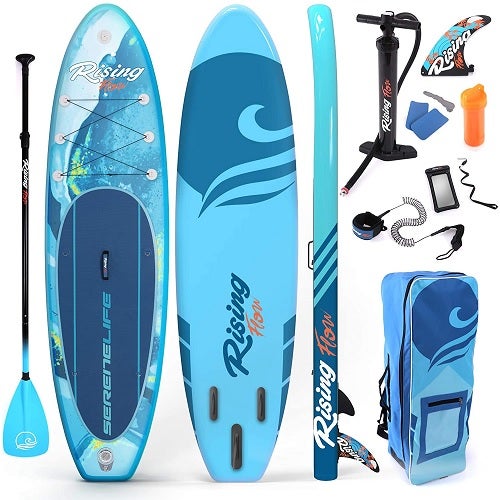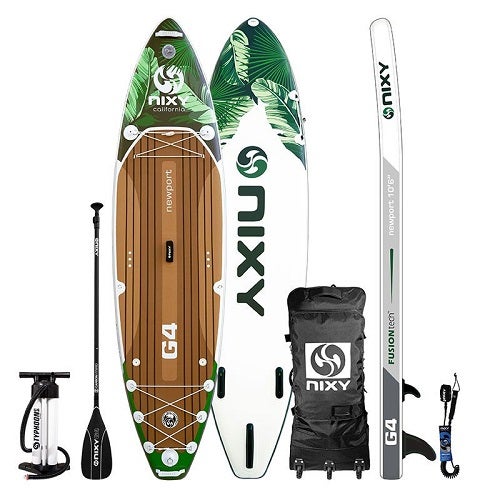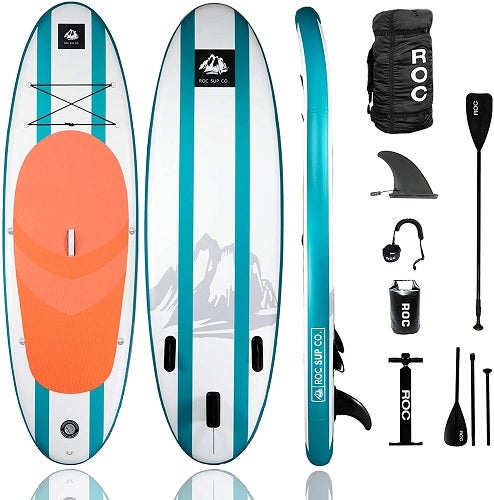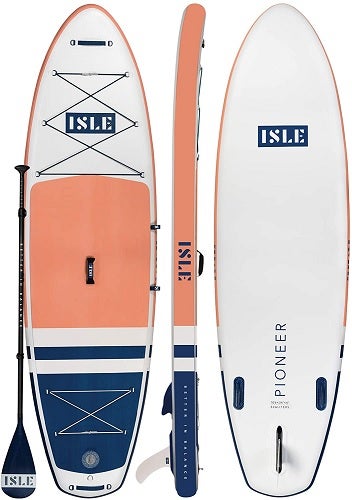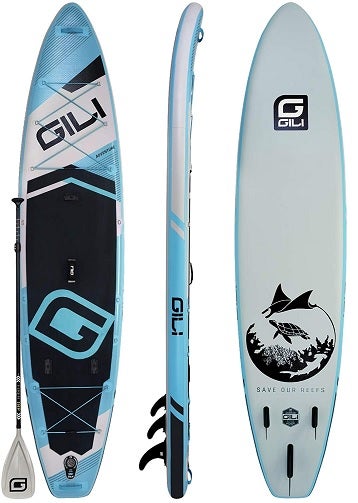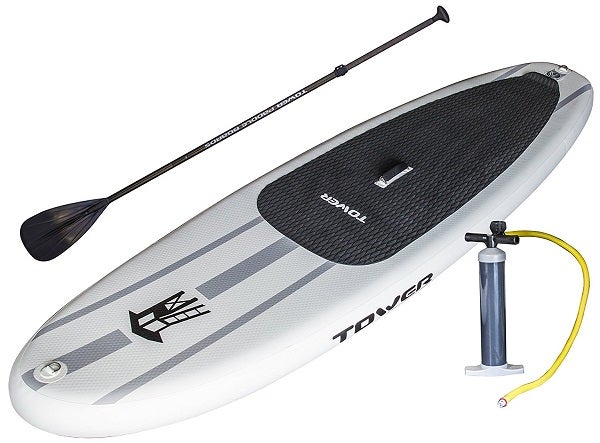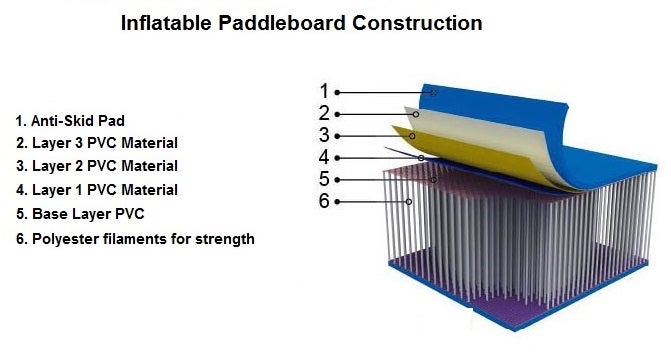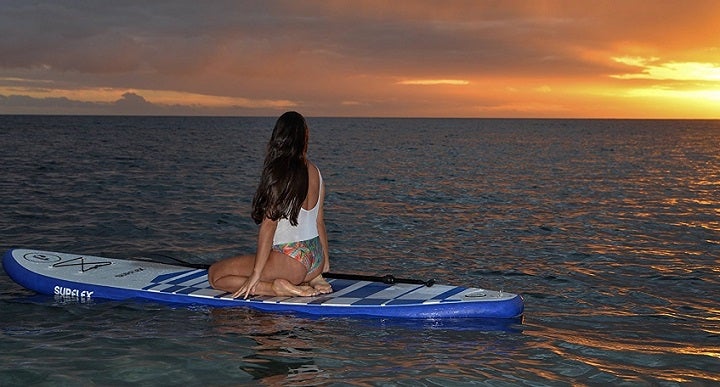
Our Editors independently research, test, and rate what we feel are the best products. We use affiliate links and may receive a small commission on purchases.
Inflatable stand-up paddle boards (iSUPs) have some big advantages over their traditional hardboard counterparts and their convenience is hard to overstate.
While traditional SUPs are heavy and hard to transport, inflatables allow you to go from backpack to paddling in under 10 minutes.
So how do you decide which iSUP is best for you?
There are surprisingly large differences between the various models.
I have personally tested all the SUPs reviewed here and for many I made a video of my impression of them to assist you in buying the best inflatable SUP for you.
They were evaluated on stability, ease of inflation, portability, value and how easy they were to paddle.
Best Inflatable Paddle Boards
For more of my paddle board recommendations, have a look through these popular Outside Pursuits guide links: SUP Paddles, Life Jackets, Electric Inflatable Pumps.
Quick Answer: The Best Rated Inflatable SUPs
- SereneLife Inflatable Stand Up Paddle Board
- NIXY Newport All Around Inflatable Paddle Board
- ROC Inflatable Stand Up Paddle Board
- ISLE Pioneer Inflatable Stand Up Paddle Board
- GILI Adventure Inflatable Paddle Board
- Murtisol Pro Inflatable Paddle Board
- iROCKER Inflatable Stand Up Paddle Board
Our reviews of the top rated inflatable SUPs along with our comparison table and buying guide below will help you choose the right iSUP for you.
Inflatable SUP Reviews
#1 SereneLife Inflatable Stand Up Paddle Board Review
- Construction: Triple layered, military grade PVC with drop-stitch construction
- Max Weight: 300 Pounds
- Inflated Size: 10’6″ Long x 32” wide x 6” thick
- Deflated size: 12″ x 33″
- Weight: 17 Pounds
- Includes: Inflation pump, 3-piece adjustable paddle, 3 fins, carry backpack, leash and patch kit
When I first tried the SereneLife Inflatable Stand Up Paddle Board I was very impressed. This is a very inexpensive iSUP that is designed to be as close to a standard epoxy paddle board as possible.
It paddles more like a rigid paddleboard because it’s more streamlined than the typical iSUP. Its very stable at 32 inches wide, 6 inches thick and the 10’6″ ft long model supports over 300 pounds of rider and cargo.
It has maybe the most unique color pattern of any SUP I have seen! It’s also available in more traditional aqua and blue colors.
You could have two riders on this board or bring your dog. The diamond groove pattern on the deck is slip resistant, so even when it gets wet so you can stay on the board if it gets a little rough.
Like all the iSUPs I review, it has a drop stitch internal construction design that makes the board very tough and durable.
SereneLife designed this board with a tri layer of military grade PVC making it very tough.
Most iSUPs only have a single or at best a double layer construction so you can be assured this board is going to last!
Like most inflatable sup boards the SereneLife comes as a complete kit; meaning you get the board, an adjustable aluminum paddle (that floats), a pretty good backpack to transport the iSUP, a high volume pump, leash and a repair kit.
Everything you need to get you on the water.
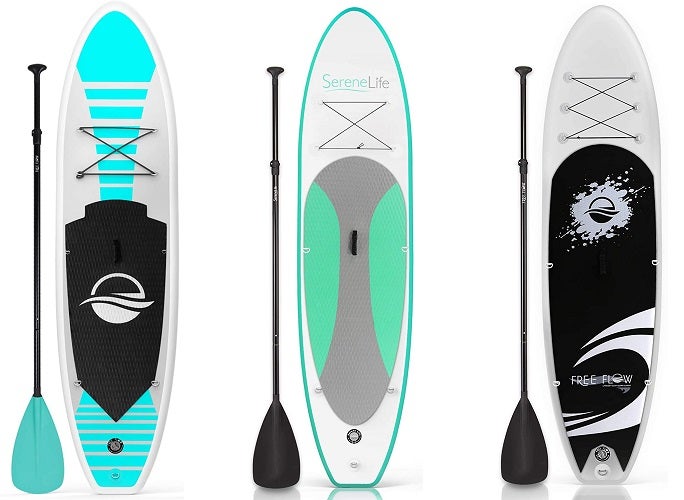
The SereneLife paddleboard comes 1 year warranty that covers any manufacturing defect, (very unlikely).
The paddle board has bungee cords in the front of the SUP to carry some cargo or hold your paddle while resting plus it has stainless steel D-Ring in the back to attach a leash.
Probably the best inflatable paddle board under $400, it would be hard to go wrong with this head turner!
#2 NIXY Newport All Around Inflatable Paddle Board Review
- Construction: Fusion Laminated Dropstitch Technology
- Max Weight: 300 Pounds, can be exceeded by experienced paddlers
- Inflated Size: 10’ 6” Long x 33” wide x 6” thick
- Deflated size: 11″ x 36″
- Weight: 21 Pounds
- Includes: Dual chamber pump, 3-piece adjustable carbon fiber paddle, 3 fins, carry bag with wheels and leash
iSUPS have come along way in the last few years and the NIXY is a perfect example of how good they have become.
The first thing I noticed when I opened the box was the carry bag. It is by far the best one I have seen yet. They thoughtfully designed it with roller wheels, it was good impression!
So if your transporting your iSUP any distance you are going to love being able to pull it behind you like a roller board suitcase.
Not only that, there is plenty of additional storage in the bag to carry along a life jacket, water bottle etc.
Video: First impression of the NIXY Newport G4 All Around Inflatable iSUP.
Once you unfold the paddle board you immediately notice they included deck rigging in the front and a large thick deck pad. If you take along a passenger they will appreciate the comfort.
With the dual chamber, triple action pump I was able to inflate it in a few minutes.
Inflating an iSUP can be a bit of a workout but the high volume pump makes the task much easier than most other single chamber pumps that come with cheaper SUPs.
It really is a big upgrade!
NIXY recommends about 15 PSI or so but truth be told, you don’t need that much.
Now, I am about 165 pounds so I can get away with it. If you are heavier or have two passengers I would go with the recommended 15 PSI.
You can go all the way up to 20 PSI! At that pressure it would be almost indistinguishable from a standard epoxy SUP.
If you are going to be a frequent paddle boarder, I would highly recommend getting an electric inflation pump.
At 33 inches wide, it’s a stable board and easy to paddle. The board has a 3 fin design for excellent tracking. Unlike cheaper iSUPs, the fins don’t just slide in, they snap in and are secured with a thumb screw.
I like the threaded mount points, here you attach a GoPro camera, fishing rod holders etc.
Excellent design NIXY!
If you want to attach a seat, you can easily do that with the attached D-rings.
The NIXY is one of the best iSUPs for the money! For about the same amount as other boards, you get a better quality SUP and wheeled carry bag. Plus all the accessories you need to get started.
#3 Roc Inflatable Stand Up Paddle Board Review
- Construction: PVC multi-layer drop stitch
- Max Weight: 350 Pounds
- Inflated Size: 10′ Long x 33” wide x 6” thick
- Deflated size: 10″ x 34″
- Weight: 17 pounds
- Includes: Pump, 3-piece adjustable aluminum paddle, dry bag, leash and carry backpack
The ROC Inflatable SUP is one the more inexpensive paddle boards on the market. Even at a bargain price I found the performance on par with iSUPs costing much more.
It is made from a high quality, quad layer commercial grade PVC with drop stitch construction for rigidity. Inflated the iSUP is 10′ by 33 inches wide, so it is a stable board and ideal for beginners.
ROC recommends a max weight load of 275 pounds but I think that can be exceeded. You can easily take two people and/or your dog without a problem.
Even at a bargain price of about $350 it is very comparable to more expensive iSUPS. Where you will notice the difference is the accessories, like the lack of wheels and storage pockets on the carry bag and the single chamber pump.
Video: First impression of the ROC Stand Up Inflatable Paddle Board.
However, at almost half the price of other boards, I would say this is a pretty acceptable trade off.
The deck of the paddle board has an anti-slip deck pad that gives you sure footing and cushioning when you are out on the water all day.
The ROC iSUP can be inflated up to 15 PSI but you can ride at 10 PSI and really not notice any difference.
It has a tri-fin setup to provide good tracking, the center fin is longer and removable.
I liked that they included bungee cords in the front for storage or a place to secure your paddle if you want to take a break. ROC even includes a dry bag to store your cell phone, keys etc.
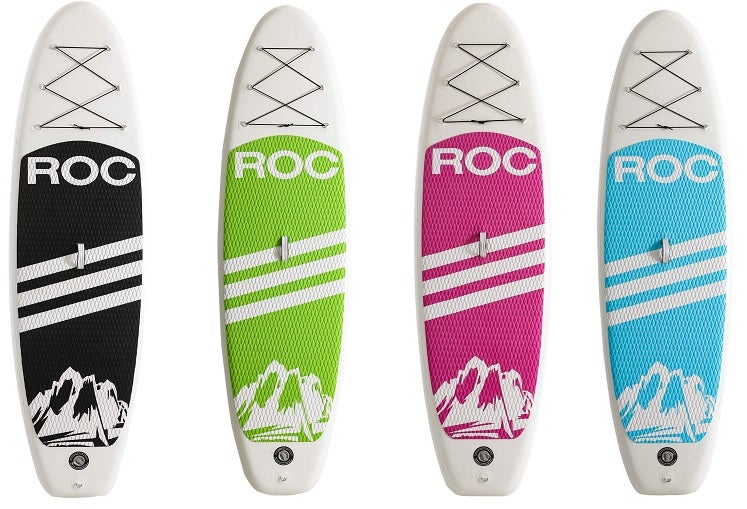
They give you a 3-piece aluminum paddle that works fine, however if you plan on paddling for long periods of time, I would upgrade to a lighter carbon fiber paddle.
Overall the ROC is the best beginner inflatable paddle board that inflates quickly and will have you from your car, to on the water in under 10 minutes, while fitting in the smallest of cars.
If your not looking to spend a lot of money, the ROC is a good budget priced iSUP.
#4 ISLE Pioneer Inflatable Stand Up Paddle Board Review
- Construction: Military grade, dual layer PVC with drop-stitch construction
- Max Weight: 285 Pounds
- Inflated Size: 10’6″ Long x 34” wide x 6” thick
- Deflated size: 12″ x 36″
- Weight: 24 Pounds
- Includes: Pump, 3-piece adjustable paddle, 3 fins, carry bag, leash and patch kit
Another solid contender in price and features is the ISLE Pioneer iSUP Board. It is made of military grade, triple layer PVC rubber with drop stitch construction and is made to last.
The Pioneer is almost indestructible, you can literally run it over in your car and not hurt it! It is almost impossible to puncture the paddleboard with normal use, so you can feel confident taking it most anywhere.
It has a good amount of nose rocker so it can handle rougher water allowing you to take it out in the ocean, rapids or a lake and in my opinion is the best inflatable SUP for surfing.
With a diamond groove pattern on the deck of the blow up paddle board gives you exceptional traction and it has 3 fins for good tracking.
The Pioneer is available in three attractive colors and will hold just over 285 pounds of weight.
At 6 inches thick (our recommended thickness) provides more rigidity than many other iSUPS. With ample front & rear bungee cord deck rigging it’s easy to store gear like a cooler or PFD.
At 34″ inches wide, it’s the widest iSUP on our list and is the most stable. If you are new to paddle boarding, this is the board for you!
Isle is so confident you will love their paddle board they offer an unprecedented 60 day guarantee that says; If you don’t love it for any reason, they will take it back.
The ISLE Pioneer Inflatable Stand Up Paddle Board is an excellent mid-priced inflatable stand up paddle board.
#5 GILI Adventure Inflatable Stand Up Paddle Board Review
- Construction: Dual layer Fusion Technology PVC with drop-stitch construction
- Max Weight: 300 Pounds
- Inflated Size: 12″ x 32” wide x 6” thick
- Deflated size: 12″ x 33″
- Weight: 19 Pounds
- Includes: Pump, 3-piece adjustable carbon hybrid paddle, 9″ center fin, carry bag and patch kit
Coming in squarely in the middle price range, the GILI Adventure iSUP packs all the features and quality construction of iSUPs costing much more. The GILI is 6 inches thick so when properly inflated is a VERY rigid board giving you stability and ease of paddling.
This has been one of the knock of iSUPS and that is they are not as rigid as a traditional epoxy board and are harder to paddle and lack the stability.
The GILI Adventure iSUP, while not quite as rigid as a epoxy SUP, it is VERY close. So if you want to use it for touring, yoga or fishing the Adventure iSUP performs well.
It features drop stitch construction to give it rigidity plus being made of Fusion Dual Layer Technology material it is extremely tough and one of the lighter iSUPs at only 19 pounds.
Video: First impression of the GILI Inflatable Stand Up Paddle Board.
The Adventure has plenty of storage capacity with front bungee cord tie downs for a cooler or PFD. It also has 16 D-rings all around the board to attach a leash and other gear.
The top of the board is soft and grippy so you or your riding companions won’t slide off the board.
Feel free to take your dog with you, his claws are not going to puncture this board.
Coming in with a volume of 225 liters, means this iSUP will support a rider and gear up to 280 pounds but you can be exceeded for experienced paddlers.
The GILI iSUP comes as a complete package with all the standard accessories like a high volume 2-Stage hand pump, carry backpack, 3-piece adjustable paddle and a leash.
You can buy this iSUP with confidence, it comes with a 2 year manufacturer’s warranty covering defects PLUS a 60 day no questions asked return policy if you don’t completely love it.
#6 Murtisol Pro Inflatable Paddle Board Review
- Construction: Military grade PVC with drop-stitch construction
- Max Weight: 280 Pounds
- Inflated Size: 10.5′ Long x 33” wide x 6” thick
- Deflated size: 12″ x 33″
- Weight: 21 Pounds
- Includes: Dual chamber pump, 3-piece adjustable paddle, 3 fins, carry bag, 10L dry bag and patch kit
Murtisol is a newcomer into the US market for inflatable paddle boards. They are aiming at the top competitors in this space like Tower & iRocker Paddle Boards and in my opinion they have equaled them.
Like any high quality iSUP, it is 6” thick and made from a military grade PVC. The Murtisol Pro is double layered for extra strength. It comes with a complete package of equipment with everything you need to get started.
The triple action, with dual chambered high volume pump will inflate the Murtisol Proin under 5 minutes and provides a nice warmup before getting on the water.
This is the only iSUP in its price range to have a dual chamber pump. It’s a bigger deal than it seems because it will inflate the SUP in half the time!
It comes with the highest quality backpack of any iSUP package in its price range as well. It’s not some cheapie one that was just included to give you something.
The iSUP fits in it perfectly and makes taking the Murtisol Pro anywhere you go easy and convenient. The Murtisol inflatable paddleboard comes with a 1 year manufactures warranty.
It covers any material or workmanship defect. In the unlikely event you have a problem, they have excellent customer service, a real person will answer the phone and help you.
The deck of the blow up paddle board has a crocodile skin texture for slip resistance and comfort. Perfect for all day on water, a furry friend and is great for yoga as well.
The included 3 piece paddle is made a light-stiff fiberglass that floats. Unlike most included paddles of most SUP packages.
The first time you drop it in the water you will appreciate the fact it floats! Also included is a leash so when you fall in the water the board can’t go too far.
They have a D-ring in the back of the board and around the sides to connect the leash and a seat, good design Murtiso!
The bungee deck cords in the front of the board allow you carry tons of gear and not worry about it falling off the board if you hit some rougher water.
The Murtisol Pro weighs only 22 pounds and folds up to 12” by 33” and comfortably carry 300 pounds of rider(s) and cargo. In our opinion it’s the best inflatable SUP under $500.
#7 iROCKER Inflatable Stand Up Paddle Board Review
- Construction: Triple layered, military grade PVC with drop-stitch construction
- Max Weight: 370 Pounds
- Inflated Size: 10′ Long x 32” wide x 6” thick
- Deflated size: 12″ x 35″
- Weight: 24 Pounds
- Includes: Dual chamber inflation pump, 3-piece carbon paddle, 3 fins, wheeled carry bag, leash and patch kit
When I first tried out the iRocker inflatable paddle board I was very impressed. This is a quality iSUP that is designed to be as close to a standard epoxy paddle board as possible.
Of course it’s not the same but when you inflate it to its recommended 15 psi it does come close.
It paddles more like a rigid paddleboard because it’s more streamlined than the typical iSUP. Its very stable at 32 inches wide, 6 inches thick and the 10 ft long model supports 370 pounds of rider and cargo.
You could easily have two riders on this board with room to spare or bring your dog. The diamond groove pattern on the deck is slip resistant, so even when it gets wet so you can stay on the board if it gets a little rough.
Video: First impression of the iRocker Inflatable Paddle Board.
Like all the iSUPs I review, it has a drop stitch internal construction design that makes the board very tough and durable. iRocker designed this board with a triple layered military grade PVC making it maybe the toughest iSUP on the market.
Most iSUPs only have a single or at best a double layer construction so you can be assured this board is going to last!
Like most inflatable sup boards the iRocker comes as a complete kit; meaning you get the board, an adjustable carbon paddle (that floats), an excellent carry bag to transport the iSUP, a dual chamber high volume pump, leash and a repair kit.
Everything you need to get you on the water.
The iRocker paddleboard comes with an industry leading 2 year warranty and I would say it’s the best inflatable paddle board under $500.
The paddle board has bungee cords in the front and rear of the SUP to carry some cargo or hold your paddle while resting plus it has stainless steel D-Rings all the way around attach gear and a leash.
Irocker now includes “action” mounts, these are thread mounting points for cameras, rod holders etc. This is a nice added feature!
You may want to consider adding a seat for the iRocker, its nice when you want to take a break and sit on the board.
Inflatable Paddle Board Comparison Table
| iSUP | Length | Width | Max Weight | SUP Weight | |
|---|---|---|---|---|---|
| Roc Inflatable Stand Up Paddle Board | 10' | 33" | 350 lbs | 17 lbs | |
| ISLE Pioneer iSUP Package | 10’6” | 34" | 285 lbs | 24 lbs | |
| NIXY Inflatable SUP | 10'6" | 33” | 350 lbs | 19 lbs | |
| SereneLife Inflatable SUP | 10'6" | 32” | 300 lbs | 17 lbs | |
| Murtisol Inflatable Paddle Board | 10'6" | 33" | 280 lbs | 21 lbs | |
| GILI Adventure iSUP | 11' & 12' | 32" | 300 lbs | 19 lbs | |
| iRocker Inflatable Paddleboard | 10' | 32" | 370 lbs | 24 lbs |
Beginners Guide To Choosing The Best Inflatable Paddle Board
- Characteristics of an Inflatable SUP
- iSup vs Fiberglass
- Pros
- Cons
- How We Evaluated The SUPs
- Paddle Board Accessories
- Best Inflatable Paddle Board Brands
Considerations For Inflatable Stand Up Paddle Boards
Length
So let’s take a look at some things you need to know to choose the right iSUP for you.
The iSUP length is the primary determination of how the board handles and how fast it is. Just like with kayaks, the shorter the SUP the easier it is to turn and maneuver but the slower it is and hard to keep in a straight line.
SUP <10 Feet – Shorter paddle boards are ideal for surfing with their short length and good maneuverability. Short boards are also ideal for kids because they are easy to turn and manuerver.
SUP 10-12 Feet – This is the “typical” size for a inflatable paddle boards. These are excellent all around boards for beginners to intermediate paddlers.
SUP >12 Feet – iSUPS over 12 feet are typically “touring” SUPs. Their longer length makes them faster and ideal for long distance paddling. They also track better or keep in a straight line but as a tradeoff less maneuverable.
Width
The width of your iSUP is also a major factor in how it maneuvers. As you can imagine a wider board is more stable and good for beginners.
Unfortunately you give up some handling and they will be slower than a thinner iSUP?iSUPs come in widths between 29 and 36 inches with 30-33 between by far the most common width.
Thickness
Our last criteria for an iSUP is thickness. Once you determine your length and width you need to look at thickness.Most new inflatable paddle boards are 6” inches thick and provide plenty of rigidity for good performance.
You can still find some very inexpensive iSUPS that are 4” or 5” thick and while they will work fine for a lightweight paddler you would be better served going with a 6” model for not much extra money.
Height/Width
Its a good idea to try and match your iSUP width to your body type. If you’re a shorter, lighter paddler then it’s best to go with a narrower board because you will have a much easier time maneuvering it. While a taller, heavier person needs a wider more stable board.
How Will You Use It?
If you plan on touring or going out for hours with a cooler and other gear, you should keep in mind you will need more storage area. A wider board of 31-33 inches should be sufficient. You also want to look for bungee cords to lash down gear and D-Rings around the board to attach gear so it doesn’t fall off the board.
Hull Shape
Much like kayaks, a paddle board with a flat bottom gives it more stability and easier to turn but they are also much slower. A displacement hull is similar to a sailboat hull and tend to be the fastest of hull designs.
Probably the best compromise for a hull shape is a planning hull. A planning hull is more rounded and faster than a flat bottom but it is somewhat easier to tip over than a flat hull. It is the best overall design for beginners and experienced paddleboarders.
Nose Rocker
The rocker refers to angled the front of the board is. It is really only important in rough water or when surfing. If you don’t have much rocker the nose of the board will tend to submerge or dive under the water.
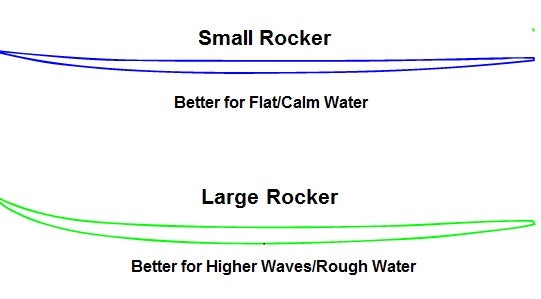
Rails
The last design consideration is the rails. This is only a consideration if you are looking to use your paddle board to surf. Rails will give you the ability to “carve” into the waves.
Now that we are familiar with the hull shapes, lets examine the pros and cons of inflatable paddle boards.
Inflatable Paddle Board vs Rigid Epoxy Paddle Board Comparison
To make a fair comparison, we took two identical sized SUPs, an iRocker and compared it to a Isle Versa. In comparing the two, overall we were surprised by the VERY small differences. The rigid SUP was slightly faster (by about 10%) and a bit easier to paddle.
Obviously the epoxy was more rigid but we were able to do all the same activities like Yoga and fishing along with being able to carry all the gear we needed like a cooler and backpack etc.
It was just slightly faster to go from car to the water with the epoxy SUP but not much as you might think. By using an electric SUP pump we could get it down to less than 5 minutes.
Pros
Portability – Well the most important pro is portability/ease of transport. They can be deflated and stored in a dufflebag and fit in just about any car.
This is a course a huge advantage over standard SUP where you will have to put it on the top of your car with a roof rack or in the bed of a truck.
Most inflatable paddle boards will inflate and deflate quickly allowing you to go from car to on the water in under 10 minutes. Probably less time than it will take you to take the board off of your vehicle and get it to the water.
One other advantage is the ability to take your inflatable paddle board with you on a trip. Since it will fit into a duffel bag it may be free or the standard $25 checked bag fee.
Durability – Modern construction materials like heavy duty urethane are incredibly tough. They will take more abuse than you will likely ever throw at them.
Rocks, coral, sticks etc will not pop an inflatable paddleboard. The nice thing about them is that they wont chip, crack or dent like a standard SUP.
Storage – Not only are inflatable SUP’s easy to transport, they are easy to store. The ability to fit one into a duffle bag allows even the smallest apartment dweller or someone with very little room in their house or condo to keep one. This factor alone makes an inflatable SUP almost a no brainer.
Cost – Inflatable SUP’s have come down significantly in price. A good quality one can be had for less than $500, including the paddle, pump and storage bag.
More Forgiving – Falling on a standard SUP can be a painful experience. An inflatable SUP with be more soft and less likely to cause an injury. They are especially desirable for kids who may not have the balance as an adult.
Cons
Setup – A inflatable SUP board will take anywhere from 5 to 10 minutes to inflate depending on the size of the board and quality of the pump. Plus you will always need to take a pump with you and put on the fins.
Speed – Just like inflatable kayaks, they are slower, since they need to be thicker and wider to provide adequate rigidity.
Surfing – If this something you want to do as you get more experienced, an inflatable paddleboard has a fatter rail making it more difficult to carve turns.
How We Evaluated The Inflatable Paddle Boards
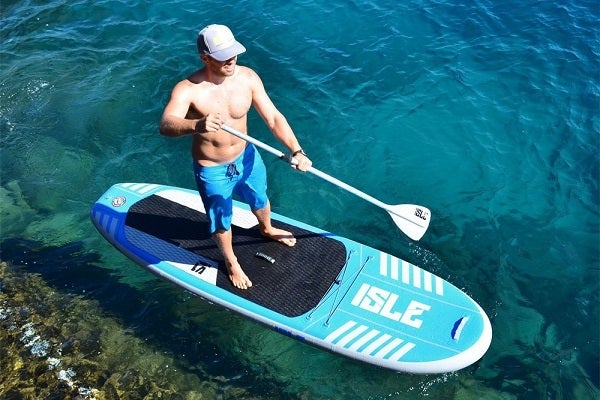
Stability
This was our number one consideration when evaluating an inflatable paddleboard. Since they tend to be used by beginner and intermediate boarders who want a board to be as stable as possible.
Naturally the bigger the board the more stable it is. But the primary thing that gives a board its stability is how thick it is. The thicker the board the more rigid and stable it usually is. 4 inches thick is the minimum recommended thickness.
Paddling Performance
By its nature a inflatable stand up paddle board will not cut through the water as well as a standard fiberglass board. However the better quality paddle boards will glide through the water noticeably easier than the cheaper boards.
Typically a higher rocker aids in how well it cuts through the water and makes it easier to paddle in rougher water or winder conditions.
Ease of Transport
Being that the main reason to buy an inflatable paddle board is because it easier to transport and store this is an important consideration.
While as stated above they do not cut through the water as well the ability to transport in almost any car without needing a roof rack and being able to store one almost anywhere, makes the inflatable SUP very desirable.
All of the boards tested required a little extra effort to get them back in the storage container after they were inflated except for the Isle Airtech. A nice feature also with the Isle Airtech was that the center fin did not need to be removed.
Speed/Ease of Inflation
Blow up paddle boards have standardized on pumps and how the pump attaches to the board so there is not really any standouts in this category.
Normally it will take you between 3-5 minutes to inflate one, depending on the size of the board and how fast you can pump.
Most paddle boards recommend an inflation PSI of 12-15. One drawback we noticed was the gauges sucked and were very inaccurate. It is impossible to over-inflate them, so when in doubt, keep pumping until it feels hard enough to hold you.
Value For The Money
The paddle boards tested were in the range of $350 to $750. With the more expensive paddle boards being made of higher quality plastic and usually come with a better quality paddle, pump and other accessories.
The paddles that come with the boards are made from aluminum shafts with plastic blades.
Paddle Board Accessories
Paddle
All of the reviewed inflatable paddle boards come with an adjustable aluminum paddle, that tend to be on the heavy side but durable. They are collapsible so they can be easily transported. If you are looking for a lighter, higher quality paddle, carbon fiber is worth looking into such as the 100% Carbon Fiber ‘Slider’ SUP Paddle.
Backpack
Since you will most likely be paddling fairly close to where your car is, you may not need a backpack to transport it. However, if you need to hike to where you want to go, a backpack is going to be something you want to purchase.
PFD/Life Preserver
None of the reviewed paddle boards come with a PFD but you can buy one for $20 – $50. You will need to one to paddle board in some areas and you should at least keep one on your board as a matter of practice. The ABSOLUTE OUTDOOR Onyx is a good option. You can see all of my recommended PFDs here.
Paddle Board Leash
This is really only an absolute necessity if you are surfing or paddling a river. When you’re starting out it’s a good idea to use one.
Roof Rack
While the small size of an inflatable paddle board is one of its primary advantages, if you are going to be at same place for a few days or more you may not want to inflate and deflate your paddleboard every time you use.
A good option is the Surfboard Soft Rack LOCKDOWN Premium Surfboard Car Racks, it will easily transport 2 SUP’s. You can see all of my recommended SUP roof racks here.
Electric Pump
If you get tired of hand pumping your paddleboard, there is the option of a battery powered pump. Not does it save you having to pump it, an electric pump will inflate your paddleboard faster.
Here is a good option, Sevylor 12 Volt 15 PSI SUP and Water Sport Pump, it plugs into your car accessory port and will inflate your paddle board in 3-5 minutes. You can see all of my recommended electric SUP pumps here.
How to Buy An Inflatable Paddle Board
Before you buy your paddle board, here are a few questions for you:
- What Will You Use it For? – Planning on using it on a river or lake? Or will you be using it on the ocean or a bay? Maybe you are thinking about trying some surfing with your paddle board. There are iSUPs that will meet your needs. Our guide above cover these aspects in detail but in general a wider board is more suitable for rougher conditions and be easier to stand up on for surfing.
- Consider Your Ability and Skill Level – If you are a newbie, a wider and longer board is much easier to balance on and stand up on. It would be preferable to to get a board at least 32” wide like the iRocker and 10’ or more long.
- Can You Store and Transport it? – Do you have room in your house or apt to store the paddle board? Do you have a vehicle to transport the paddle board? You will most like want a rack to transport it safely. If you don’t then the inflatable paddle boards we have reviewed are perfect for you.
- What Type of SUP Do You Want? – Since we have been covering inflatable SUPs in this article we are assuming that is what you are looking for. You may want to consider the advantages again of the rigid SUPs before making your final decision.
- What is Your Budget? – How much are you willing to spend on your SUP? We have covered a wide price range in this review. You can get an iSUP for as little as $250 and all the way up to over $1000. You can get a very good quality on in the $500 range that comes with everything you need to get on the water.
FAQs About Inflatable Paddle Boards
Q: How do I stand on a Paddle Board?
A: The easiest way to start is to kneel on the board and start paddling. As you gain confidence, move one of your knees up so you are on one knee and one foot the push up your other foot so you are standing.
Q: How to you keep your balance on a paddle board.
A: A common mistake is standing on a paddle board like it’s a surfboard. Meaning your toes are facing the side of the board. You want to have both feet facing forward and your knees should be slightly bent. Remember when you paddle to use your entire core not just your arms.
Q: How heavy is an inflatable paddle board?
A: Inflatable SUPs vary somewhat in weight depending on its length and width but usually weigh as little as 18 pounds and a heavier board may weigh up to 30 pounds.
Q: Is paddle boarding good exercise?
A: The simple answer to this question is yes! Paddle boarding is an excellent full body workout for your entire body.
Q: What are inflatable paddle boards made from?
A: iSUPS are made from a PVC that uses something called “Drop Stitch” construction that when it gets inflated gets very rigid, similar to a traditional epoxy paddle board.
Q: Are inflatable paddle boards any good?
A: Yes! They have come a long way and when they are properly inflated they are almost identical in performance to a epoxy paddle board when you use the latest 6” thick models.
Q: What are the different types of stand up paddle boards?
A: There are quite a few types of paddle boards, each designed for different puposes and materials. There are solid core epoxy SUPs, inflatable SUPs (iSUPS), racing/touring SUPs, yoga SUPs, surfing SUPs.
Q: How much is an inflatable paddle board?
A: iSUPS range widely in price. Cheaper, beginner SUPs can cost as little as $250 and go up to $1000 for a high end touring model.
Q: How long is the typical stand up paddle board?
A: It depends on what the paddle board is being used for. The typical, all around paddle board ranges between 9 and 10’6”. They come in longer models that are used for long distance touring.
5 Tips For Beginner Paddle Boarders
Once you get your new board it’s time to learn how to use it safely. While paddle boarding is relatively easy, the first few times can be a challenge.
With some time and practice you will be an expert in no time. But when you are first starting out here are a helpful tips.
1. Take it Slow at First
Don’t plan on taking long paddles at first, it is best to take short paddles at first and learn how to stand on the board and get confident. You will also find that you may be using muscles that you have not used before. Paddle boarding is an excellent full body workout.
2. Don’t forget to use a leash
No we don’t mean a dog leash, a paddle board leash will strap around your ankle with velcro and connecto to a D ring on the SUP. A leash will prevent you from getting separated from the SUP when you fall in. As you get more experience you may skip using one, but while you are learning always use one.
3. Keep Your Distance
This is more applicable to smaller lakes or crowded beach areas but you want to allow plenty of distance between you and other boarders, kayakers or swimmers. There is plenty of room, so keep your distance.
4. Learn How to Fall
When you are learning how to paddle board, falls are inevitable. To avoid getting injured when you fall you need to learn how to fall properly.
Inflatable paddle boards are not soft to fall on so it will hurt if you fall on it or get hit with it when you fall off.
The main thing you need to keep in mind is to fall away from the board. So when you feel yourself falling try and push yourself away and don’t fall stright forward or back.
This is something you should practice before hand so you know how to do it properly. This is why you want to use a leash so that the board cannot get to far away from you.
5. Make Sure Are Paddling the SUP in the Right Direction
I know this may seem super obvious but if you are new to paddle boarding but it may not be obvious when the board is in the water.
To make sure you are facing the right way, look for the fins. They should always be in the back and your back should be to them. The fins are used for tracking and help keep the board in a straight line. If they are in the front, they will not be able to do their job.
Video: Some Tips on Paddle Boarding to get you started.
Best Inflatable Paddle Board Brands
After trying out quite a few inflatable SUPs I think we have a good handle on the best brands. There is of course some subjectivity but as far as overall rigidity, tracking, ease of paddling and accessories I think these are the best brands for you to consider:
- Tower Paddle Boards
- SupFlex
- Isle
- iRocker
If you go with any of these, you will have a good experience and many enjoyable hours on the water.
Conclusion
As you can see there are quite a few excellent iSUPs on the market and I cant cover them all. When you are just starting out you want a paddleboard that is stable and the Tower and SUPFlex are two of the best in this area. If you are looking for a budget priced option then the ROC might be your best choice.
If you need some information on how to get the most out of paddle boarding, here is a complete guide. Once you get comfortable on your paddle board and your looking to try something different, here is a guide on how to do paddle board yoga. Don’t forget that a good paddle is almost as important as your SUP, check our reviews here.
How We Researched
To come up with the top inflatable paddle boards, we researched a variety of sources for reviews such as REI, Dicks Sporting Goods, West Marine and Backcountry along with our own personal experience. We also consulted online magazines for product research and reviews to get as much unbiased information as we could. To help weed out fake reviews we used Fakespot.com to make sure we only looked at genuine reviews.
With so much quality gear available, we had to narrow it down based on what we felt were the best options were for the price. The author, Richard Remick has been an avid paddle boarder for over 10 years. To help narrow down the selection he used his personal experience along with recommendations from paddle board instructors, and rental shops. After extensive research, we came up with our list to help you choose the right one for you.

